
The Natural Georgia Series: The Fire Forest
Longleaf Pine-Wiregrass Ecosystem

 |
The Natural Georgia Series: The Fire ForestLongleaf Pine-Wiregrass Ecosystem |
 |
 Flora
and Fauna of the Longleaf Pine-Grassland Ecosystem
Flora
and Fauna of the Longleaf Pine-Grassland EcosystemEuropean settlers were greeted by a vast longleaf pine-grassland savanna covering 92 million acres from southeastern Virginia to central Florida to eastern Texas. Today, as a result of fire suppression, logging, development, and agriculture, this ecosystem has faded to less than three percent of its original coverage. Examples containing both old-growth trees and undisturbed understory are exceedingly rare. Second-growth stands with intact understory are more prevalent, usually occurring on gamelands, state and national forest lands, and military bases where fire is a primary land management tool. Younger sites may not accurately represent the original ecosystem; vegetation was cleared from the much of the region's best soils over a century ago for agriculture, leaving the lion's share of longleaf fragments in unusually wet or dry areas that were not suited to farming.
The importance of fire for this ecosystem's ongoing health cannot be overstated. Because natural fires are not as prevalent as they once were, prescribed burns are used to clear the ground for longleaf pine germination, remove competing hardwoods, consume understory litter, and stimulate many herbs and shrubs to fruit or flower. American chaffseed (Schwalbea americana), for example, responds to fire by flowering; wiregrass only flowers after summer fires.
Though abundant grass cover may give the impression of a uniform habitat, areas of longleaf dominance were and are far from homogenous. At Greenwood Plantation near Thomasville, a 1,000-acre tract containing one of the Southeast's finest old-growth components, over 500 plant species have been documented in the ground cover. Great geological and topographical differences obviously exist across the tree's range. Even within the Coastal Plain, soil moisture is critical in determining vegetative composition. This is one of the planet's most diverse ecosystems, harboring thousands of fire-adapted plants and animals including an estimated 27 federal endangered species and about 100 species of special concern.
Though no longer a common sight in the Southeast, the longleaf pine (Pinus palustris) is distinguishable from other pines by its unusually long, 10-inch-long needles and large, 6- to 12-inch-long cones. This is the longest-lived of the southern pines, with a life-span of 300 to 500 years, and one of the largest, reaching heights of 80 to 100 feet with a trunk diameter exceeding 2.5 feet. The longleaf pine has greater insect and disease resistance than loblolly or slash pine. Especially noteworthy is its resistance to the southern pine beetle, which decimates loblolly and slash pines.
The longleaf pine's resistance to fire may contribute to its longevity. The thick bark of an older tree makes it quite flame resilient, and long, tufted needles protect buds from fire even as the needles themselves burn.
This tree's growth cycle depends upon regular low-intensity fires. Fires expose the soil surface for seeds and provide nutrients for germination. Longleaf pines seed in the fall and germinate within two weeks, allowing an establishment period before the next summer's lightning season. Saplings remain in the "grass stage" for 3 to 10 years, devoting nutrients to developing a deep taproot and strong root system. During this period dense protective needles cover the seedling, giving the superficial appearance of a clump of grass. Once strong roots are established, the tree enters a "rocket stage" of rapid height growth, sending the terminal bud at the crown safely above the reach of surface fires.
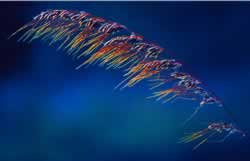 Grasses
GrassesAt least three dozen grasses occur in longleaf pine-grassland habitats, indispensable as shelter for birds and small mammals, edible grains, and fuel for fires. Grasses are wind-pollinated plants with inconspicuous flowers and extensive root systems comprising up to 90 percent of the plant's total weight. Because the growing part of a grass stem is at the base rather than the tip, grasses reappear quickly after fire. Bunch-form grasses growing in clumps, rather than sod forms, populate this ecosystem.
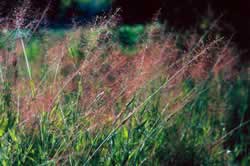 Wiregrasses,
which have narrow, stiff leaves, are a vital component of the ecosystem in parts
of Georgia, North Carolina, and most of Florida. Broader-leafed grasses such
as broomsedge (Andropogon virginicus), Indiangrass (Sorghastrum secundum),
wood grass (S. nutans), panic grass (Panicum spp.), and water
grass (Bulbostylis barbata) may also be prevalent in Georgia. Elsewhere
on the Coastal Plain, bluestem, silky scale, toothache, and dropseed grasses
become common. Bluestem grasses (Andropogon spp., Schizachyrium spp.)
replace wiregrasses in longleaf pine habitats from western Alabama to Texas.
In parts of the coastal flatlands from southeast Mississippi to southeast Georgia
and into central Florida, saw palmetto (Serenoa repens) is the dominant
ground cover species.
Wiregrasses,
which have narrow, stiff leaves, are a vital component of the ecosystem in parts
of Georgia, North Carolina, and most of Florida. Broader-leafed grasses such
as broomsedge (Andropogon virginicus), Indiangrass (Sorghastrum secundum),
wood grass (S. nutans), panic grass (Panicum spp.), and water
grass (Bulbostylis barbata) may also be prevalent in Georgia. Elsewhere
on the Coastal Plain, bluestem, silky scale, toothache, and dropseed grasses
become common. Bluestem grasses (Andropogon spp., Schizachyrium spp.)
replace wiregrasses in longleaf pine habitats from western Alabama to Texas.
In parts of the coastal flatlands from southeast Mississippi to southeast Georgia
and into central Florida, saw palmetto (Serenoa repens) is the dominant
ground cover species.
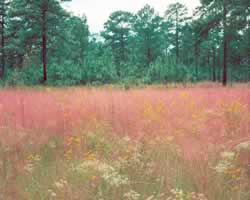 Wiregrass
WiregrassThis perennial bunch grass grows in the seasonal wet bogs and dry sandhills of the Atlantic Coastal Plain from Mississippi to southeastern North Carolina to south Florida. Carolina wiregrass (Aristida stricta) dominates in the northern longleaf woodlands but is replaced by southern wiregrass (Aristida beyrichiana) in the more southerly Coastal Plain sections. Wiregrass thrives under open longleaf pine canopies, occurring in clumps up to 6 inches across with soft, hairlike tufts at the leaf base. Flat leaves, which sometimes reach lengths of 20 inches, appear cylindrical because they curl inward at the edges.
Wiregrass's physical structure encourages fire. Overlapping leaves from adjacent clumps act as a net to catch fallen pine needles, allowing air to circulate along the savanna floor and keep the ground primed for burns. Fire spreads easily from clump to clump, burning rapidly under dry conditions. This structure also discourages the decomposition of the pine needles over a two- to three-year cycle and results in the maintenance of higher fuel loading than sites without wiregrass.
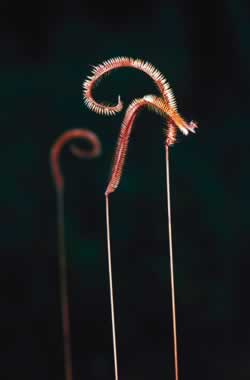 Wiregrass
and longleaf pines have a mutually beneficial relationship based on the need
for fire. Without fire, hardwood seedlings would dominate the understory, overshadowing
wiregrass and competing for moisture and nutrients (and eventually overtaking
the pine trees). Fires during growing season stimulate flowering and seeding
in wiregrass. Fire suppression can be fatal. Debris accumulated over a number
of years can fuel a fire hot enough to kill the plant's roots. Wiregrass does
not readily re-establish once destroyed.
Wiregrass
and longleaf pines have a mutually beneficial relationship based on the need
for fire. Without fire, hardwood seedlings would dominate the understory, overshadowing
wiregrass and competing for moisture and nutrients (and eventually overtaking
the pine trees). Fires during growing season stimulate flowering and seeding
in wiregrass. Fire suppression can be fatal. Debris accumulated over a number
of years can fuel a fire hot enough to kill the plant's roots. Wiregrass does
not readily re-establish once destroyed.
Members of the bean family (Fabaceae), legumes are a large and important group of over 13,000 species, exceeded in diversity only by the composites. Legumes are typical inhabitants of a fire-maintained longleaf pine-wiregrass ecosystem. Most native species are perennials and tolerant of the shade created by the open pine canopy. Identifiable by flowers that resemble peas and pod-like seed packets, legumes can be vines, herbs, or woody shrubs.
Legumes are an important source of food and/or cover for wildlife including gopher tortoises, bobwhite quail, songbirds, white-tailed deer, and pocket gophers. The plants also fix nitrogen from the atmosphere, replenishing what's lost in prescribed fires, and make these nutrients available through rapid decomposition.
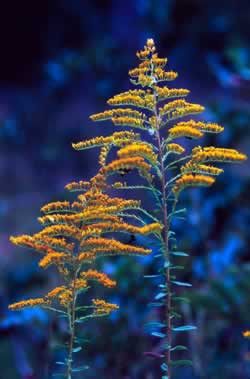 Longleaf
pine grasslands host abundant and diverse native legume species; a study at
the Joseph W. Jones Ecological Research Center in Baker Country, Georgia showed
almost 50,000 stems per acre and 43 distinct species at the research site. Common
native legumes include numerous beggarweeds (Desmodium spp.) and lespedezas
(Lespedezas spp.), goat's rue (Tephrosia virginiana), sensitive
briar (Schrankia microphylla), butterfly pea (Clitoria mariana),
dollar leaf (Rhyncosia reniformis), and rabbitbells (Crotalaria rotundifolia).
Longleaf
pine grasslands host abundant and diverse native legume species; a study at
the Joseph W. Jones Ecological Research Center in Baker Country, Georgia showed
almost 50,000 stems per acre and 43 distinct species at the research site. Common
native legumes include numerous beggarweeds (Desmodium spp.) and lespedezas
(Lespedezas spp.), goat's rue (Tephrosia virginiana), sensitive
briar (Schrankia microphylla), butterfly pea (Clitoria mariana),
dollar leaf (Rhyncosia reniformis), and rabbitbells (Crotalaria rotundifolia).
The composite family (Compositae) wears the title of the most diverse family of flowering plants on the planet. They are, along with grasses and legumes, one of the more dominant families of flora represented in the longleaf pine-wiregrass ecosystem.
Composites owe their name to their flowers: What appears to be a single bloom is actually a cluster of hundreds of tiny individual flowers pressed densely together. In most composites, tiny tubular disk flowers create the round center of the display. Ray flowers, commonly called petals, emanate from the center. The advantage of this arrangement is that during pollination, an insect can make contact with hundreds of flowers at once. Their seeds are a food source for many birds and small mammals.
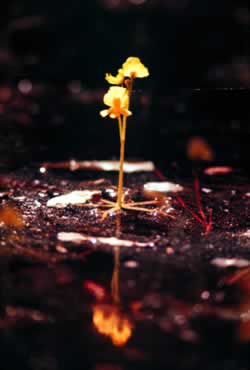 Common
examples of composites in the longleaf pine-wiregrass habitat include goldenrod
(Solidago spp.), asters (Aster spp.), goldenaster (Chrysopsis
mariana), rayless sunflower (Helianthus radula), narrow leaf sunflower
(Helianthus angustifolia), pineland daisy (Chaptalia tomentosa),
ironweed (Vernonia angustifolia), deer tongue (Carphephorus odoratissima),
blazing star (Liatris spp.), thistles, Sun's bonnets (Chaptalia tomentosa),
thoroughwort (Eupatorium cuneifolium, other spp.), and black-eyed
susan (Rudbeckia hirta).
Common
examples of composites in the longleaf pine-wiregrass habitat include goldenrod
(Solidago spp.), asters (Aster spp.), goldenaster (Chrysopsis
mariana), rayless sunflower (Helianthus radula), narrow leaf sunflower
(Helianthus angustifolia), pineland daisy (Chaptalia tomentosa),
ironweed (Vernonia angustifolia), deer tongue (Carphephorus odoratissima),
blazing star (Liatris spp.), thistles, Sun's bonnets (Chaptalia tomentosa),
thoroughwort (Eupatorium cuneifolium, other spp.), and black-eyed
susan (Rudbeckia hirta).
Members of the family Orchidaceae occur in wet pinelands and boggy areas. Flowering plants display blooms on erect stems. Southeastern varieties flower in summer or early fall.
Though it offers no nectar for insects, the grass-pink orchid (Calopogon tuberosus) has evolved to resemble flowers that do, often growing alongside nectar-bearing flowers with pink petals and yellow stamens. Its golden beard-a tuft of bristles on the plant's lip- attracts bees, whose weight causes them to be transferred to the column below the orchid's lip. Sticky with stigmatic material, the bee picks up pollen grains; when it travels to another orchid, cross-pollination is achieved.
The flowers of Pteroglossopsis ecristata, a rare, wet pineland orchid, grow clustered atop a slender, 3- to 4-foot-tall stalk and have a saclike base and light brown to deep purple, three-lobed lip. Another rare orchid, spreading pogonia (Cleistes divaricata), displays pink to white curved petals and a yellow-green lip with a rose apex and purple veins. Other orchids occurring in longleaf pine ecosystems include rose pogonia (Pogonia ophioglossoides), yellow fringed (Platanthera ciliaris), white fringed (P. blephariglottis), and spider orchid (Habenaria quinqueseta).
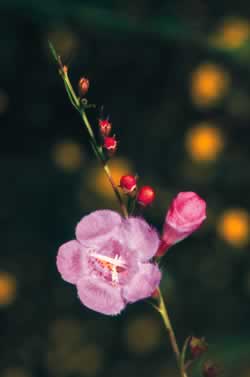 Insectivorous
Species
Insectivorous
Species Insectivorous plants are common in the bogs associated with some longleaf pine forests. They include hooded pitcher plants (Sarracenia minor), yellow pitcher plants (S. flava), parrot pitcher plants (S. psittacina), bladderworts (Utricularia inflata, other spp.), yellow butterwort (Pinguicula lutea), and sundews (Drosera capillaris, several other spp.) These plants have special structures that allow them to capture and digest protein-rich insects and spiders. When broken down, the proteins release nitrogen, a nutrient essential for plant growth. Since soil acidity slows decomposition, sources of mineralized nitrogen do not exist in bogs. Their carnivorous nature is an adaptation that allows these plants to survive.
The pitcher plant provides a good illustration of this adaptation. It secretes nectar from its hood to attract insects. An insect alights on one of the plant's hollow, tubular leaves and is lured under the hood, where it tries to escape through translucent spots in the hood. Instead, tired from the struggle, the insect falls into the liquid-filled "pitcher" of the leaf, where curved hairs prevent the prey from escaping and it is broken down by plant enzymes and bacterial action. Bladderworts use suction to trap living aquatic or terrestrial organisms that have touched the trigger hairs at the mouth of one of the bladders.
The sundew's flowers occur as clusters of white blooms on one side of a tall, leafless stalk rising above a rosette of small, sticky leaves. Pitcher plants have fiddle-shaped, yellow to reddish-green flowers that grow on separate, leafless stalks. Bladderworts and yellow butterworts have yellow flowers.
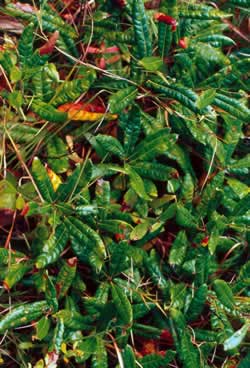 Scrub
Oaks
Scrub
Oaks Various scrub oaks comprise the sparse, broad-leaved understory (the middle layer of flora, between the pine overstory and grassy/herbaceous ground cover) in longleaf-wiregrass woodlands of the Coastal Plain and Fall-Line sandhills. Blackjack and post oaks (Quercus marilandica, Q. stellata) are prevalent where clay content is high; turkey, bluejack, and sand post oaks (Q. laevis, Q. incana, Q. margaretta) are scattered on sandier sites.
Running oak (Quercus pumila), which has evolved under fire conditions just as longleaf pines and wiregrass have, is a natural hardwood component of this ecosystem. The running oak's adaptation to fire is its ability to form a major root and trunk system underground (though not in the shape of the aboveground trunk). The tree produces a full-sized acorn that is food for quail, turkey, songbirds, and deer.
The running oak rarely grows taller than 4 feet in height, even after years of fire suppression. Without fire, this tree will eventually disappear, succumbing to shading and competition from other hardwoods. Because it is difficult to re-establish once eradicated from an area, its presence indicates healthy, virgin soil.
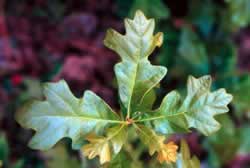 American
Chaffseed
American
ChaffseedListed as both a federally and state endangered plant, American chaffseed (Schwalbea americana) flowers in direct response to fire. Winter fire stimulates flowering April through June; early summer fire stimulates flowering July through August. Without fire, even plants that flowered the previous year will remain in a non-flowering, vegetative state.
The plant's range has shrunk drastically due to habitat destruction, clearing for agriculture, and fire suppression. Originally found from New York to Florida, chaffseed has been reduced to small, isolated populations in five states (GA, FL, SC, NC, NJ), often occurring on military lands or private lands where quail management requires dormant-season burns. In Georgia, chaffseed is found along the margins of depressional wetlands and the ecotone of upland longleaf pine forests.
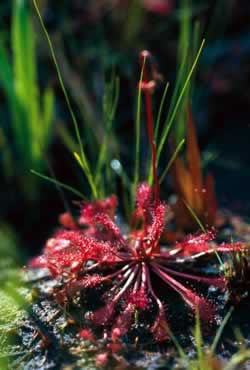 Several
members of the family Scrophulariaceae including American chaffseed are hemiparasitic:
They attach their roots to host plants to satisfy some nutritional requirements-in
the case of chaffseed, supplemental nitrogen. The exact nature of this relationship
is unknown, but it does not appear to harm host plants. Chaffseed is a non-host-specific
hemiparasite, but it does appear to favor silkgrass (Pityopsis graminifolia);
other hosts include wiregrass (Aristida beyrichiana), St. John's wort
(Hypericum spp.), and panic grass (Panicum tenue).
Several
members of the family Scrophulariaceae including American chaffseed are hemiparasitic:
They attach their roots to host plants to satisfy some nutritional requirements-in
the case of chaffseed, supplemental nitrogen. The exact nature of this relationship
is unknown, but it does not appear to harm host plants. Chaffseed is a non-host-specific
hemiparasite, but it does appear to favor silkgrass (Pityopsis graminifolia);
other hosts include wiregrass (Aristida beyrichiana), St. John's wort
(Hypericum spp.), and panic grass (Panicum tenue).
Parasitism seems critical early in chaffseed's establishment; greenhouse-germinated plants can survive for months with no host but not much beyond the young seedling stage. Chaffseed is a single- to multi-stemmed perennial with purplish-red to cream-colored flowers and a saclike structure enclosing the seed that may aid in wind dispersal. Worker bumble bees assist in pollination, but the plant can also produce seed in the absence of pollinators.
Though not listed as an endangered species, hummingbird flower (Macranthera flammea) is considered rare. Its range is the Coastal Plain from eastern Louisiana to the Florida panhandle to southwest Georgia. It requires flowing, rather than standing, water, such as occurs in seepage areas. A member of the family Scrophulariaceae, hummingbird flower-so named for the birds that pollinate it-is a biennial, hemiparasitic plant whose roots must attach to other species to make viable seed. After the seed sprouts, the plant makes a small rosette on the ground for the first year, experiencing negligible upward growth. The plant shoots up and blooms during its second year, offering a showy flower with bright orange corolla and four large stamens. It dies at the end of this two-year cycle.
The major causes for this plant's decline include fire suppression, continued wetland drainage, and excessive competition caused by eutrophication (a process in which wetlands become rich in dissolved nutrients and oxygen-deficient, often from agricultural fertilizers draining into the areas).
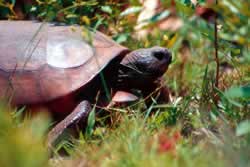 Gopher
Tortoise
Gopher
Tortoise Georgia's official state reptile and the only tortoise found naturally east of the Mississippi River, the gopher tortoise (Gopherus polyphemus) is also a threatened species. This large terrestrial tortoise traditionally resides in the longleaf pine-wiregrass community, where it finds abundant low-growing plants for grazing and sandy, well-drained soil for easy burrowing. Destruction of more than 80 percent of its natural habitat, however, has forced the gopher tortoise to adapt to grassy roadsides and fallow fields in sandy plain areas throughout Florida and from South Carolina's southern edge to eastern Louisiana.
Adult gopher tortoises range in length from 6 to 14.5 inches. Life-span is 60 to 80 years but can be as long as 100 years. Age is determined by counting the rings, or annuli on the individual scutes (sections) of the carapace, which ranges from grayish black to dark brown in color. The bottom segment of the shell, or plastron is yellowish to light brown. The animal's back feet are thick and stump-like, while its front feet resemble shovels with sharp toenails for digging. Jaws are sharp and beak-like.
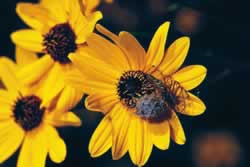 The
gopher tortoise is a keystone species for the longleaf pine-wiregrass ecosystem.
Its burrow provides feeding grounds and shelter for more than 300 other animal
species. Much of the tortoise's life is spent inside its burrow, a cavity approximately
6 feet deep, 15 feet long, and as wide as the tortoise is long (enabling it
to turn around underground). Burrows are commonly shared with Eastern indigo
snakes, Eastern diamondback rattlesnakes, crickets, flies, moths, beetles, spiders,
and ticks. The only unwelcome guests are other gopher tortoises. Famous for
retreating into their shells at the first sign of trouble, gopher tortoises
will actually fight each other to defend their territory. Combatants attempt
to flip opponents over using a protrusion under the head called a gular shield.
Gopher tortoises are most vulnerable on their backs and can rarely right themselves.
The
gopher tortoise is a keystone species for the longleaf pine-wiregrass ecosystem.
Its burrow provides feeding grounds and shelter for more than 300 other animal
species. Much of the tortoise's life is spent inside its burrow, a cavity approximately
6 feet deep, 15 feet long, and as wide as the tortoise is long (enabling it
to turn around underground). Burrows are commonly shared with Eastern indigo
snakes, Eastern diamondback rattlesnakes, crickets, flies, moths, beetles, spiders,
and ticks. The only unwelcome guests are other gopher tortoises. Famous for
retreating into their shells at the first sign of trouble, gopher tortoises
will actually fight each other to defend their territory. Combatants attempt
to flip opponents over using a protrusion under the head called a gular shield.
Gopher tortoises are most vulnerable on their backs and can rarely right themselves.
 Red-Cockaded
Woodpecker
Red-Cockaded
Woodpecker Now on the federal list of endangered species, the red-cockaded woodpecker (Picoides borealis) was once a common inhabitant of Coastal Plain pine forests. Populations have dwindled significantly from habitat loss.
Mature red-cockaded woodpeckers are about 7 inches long, with a black crown, white cheek, and back barred with black and white horizontal stripes that give a ladder-back appearance. Juvenile males have a small red area on the crown. Adult males have a thin red streak above the cheek, visible only up close or when the bird is excited.
Unlike other woodpeckers that nest in dead trees, the red-cockaded is the only woodpecker that excavates cavities exclusively in living pine trees. The birds choose trees infected with red heart disease, a fungus that softens the heartwood and allows for easier excavation. Cavities are used for nesting and roosting and generally take from one to three years to excavate. One bird occupies each cavity. The red-cockaded woodpecker is a cooperative breeding species and nests from April through June.
These nonmigratory birds inhabit territories of 125 to 200 acres and live in clans, family groups consisting of a breeding pair and one to four of the male's offspring who act as helpers. Clans spend a great deal of time foraging for food-insect larvae, cockroaches, beetles, ants, and centipedes-in tree limbs and trunks.
To protect nest cavities from predators such as tree-climbing snakes, red-cockaded woodpeckers drill resin wells around the cavity opening, allowing sticky sap to coat the tree's trunk. The white sap gives the tree a candle-like appearance.
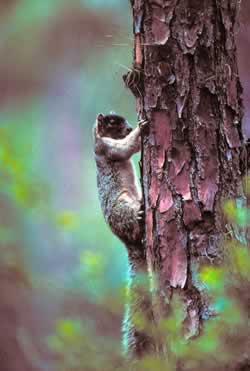 Sherman's
Fox Squirrel
Sherman's
Fox SquirrelWith the near-disappearance of the longleaf pine-wiregrass ecosystem, the population of Sherman's fox squirrels (Sciurus niger shermani) has plunged an estimated 85 percent from pre-European settlement numbers. They are indigenous to southern Georgia and northern Florida, inhabiting areas where pine seeds and acorns are abundant. They are omnivorous.
The largest of the southeastern fox squirrels, adults in this species weigh about 3 pounds and measure approximately 30 inches in total length. Body coloring ranges from tan to light gray. The squirrel's head is usually black with white ears and nose. They breed twice a year, caring for two to three babies in large, solid nests built of leaves, twigs, grass, and pine needles. The Sherman's fox squirrel will occasionally use a tree cavity for nesting.
Longleaf pine seeds are an important part of the fox squirrel's diet. It also eats mycorrhizal fungi off the trees, which, when dispersed in the squirrel's waste products join with the pine tree's roots and aid in mineral uptake. This mutually beneficial relationship between Sherman's fox squirrels and longleaf pine trees is one of many unique interactions vital to the overall health of the ecosystem.
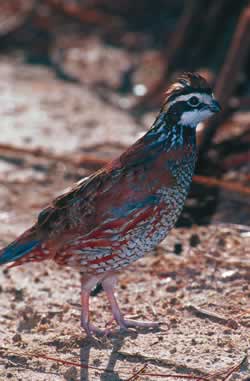 Northern
Bobwhite Quail
Northern
Bobwhite Quail Since the 1940s, bobwhite quail (Colinus virginianus) numbers have steadily declined throughout the southern United States, owing mainly to loss of habitat. Hedgerows between fields-prime quail cover-have become less prevalent as small family farms divided by hedgerows and weedy edges have been amalgamated into large fields with intensified methods. Extensive timber production and fire suppression (which allows a dense understory to choke out the herbaceous plants quail feed on) has also limited quail populations.
Adults are an irregular reddish-brown color with a short gray tail and striped flanks. Males have a white throat and eye stripe. The males' rising "bob-white" whistle is heard in spring and summer.
Quail live in groups, or coveys, until the nesting season begins in April. Courting pairs construct ground nests of dead plant matter. Average clutch size is 13 eggs, incubated by males 25 percent of the time. Juveniles are fully feathered at about six weeks, when their diet starts to shift from insects to seeds and fruit.
Because it is a premier game bird across the Southeast, efforts have been made to increase wild quail populations by releasing pen-raised birds, a restocking strategy that has not been effective. Annual survival rates for these birds are low, but they do provide hunting opportunities for sportsmen. A compromise in some managed hunting areas has been to dedicate a specific block of land to pen-raised quail while devoting most of the property to native populations. Pen-raised birds can be distinguished from wild quail by weight; their average weight is 0.44 pound, while wild birds generally weigh about 0.35 pound.
Also called the "sandy mounder" or "salamander," the southeastern pocket gopher (Geomys pinetis) lives underground much of the time in an extensive network of tunnels that may reach 500 feet in length. As the gopher digs, it pushes the sandy soil up in a row of mounds above the ground. It stores in cheek pouches the bulbs, roots, and tubers that it encounters while digging. When its pouches are full, the pocket gopher deposits this plant matter in chambers dug specifically for food storage. The gopher's burrow system also includes a latrine chamber and a grass-lined nesting chamber.
To aid in digging, the pocket gopher has enlarged front claws. It has small eyes and ears and large incisors and cheek pouches. Adult pocket gophers are 9 to 12 inches long, including a 3- to 3.5-inch-long hairless tail. Coloring ranges from light to reddish-brown on the back, with a tan or buff underside. The pocket gopher is a solitary animal except during biannual breeding seasons, in February or March and then again in June or July.
The pocket gopher's predators include snakes, hawks, owls, weasels, skunks, and foxes.
The non-poisonous Eastern indigo snake (Drymarchon corais couperi) is in such peril that it is listed as a threatened species both federally and in Georgia. It has been widely collected by human beings, perhaps for its distinctive coloring, mild manner, and the fact that it is the longest snake in North America. Formerly occurring from Mississippi to Florida to South Carolina, the indigo snake's habitat has been reduced to include only Florida and Georgia's Coastal Plain. It resides in sandhill communities inhabited by longleaf pines and gopher tortoises, whose burrows indigo snakes share in the winter.
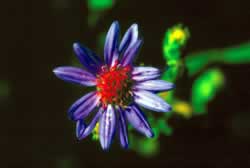 Indigo
snakes have smooth scales and are uniformly blue-black in color with occasional
reddish or off-white spots on the head. Adults average 6 feet in length; the
longest indigo snake on record measured 8.6 feet. Exclusively carnivorous, they
eat venomous snakes such as rattlesnakes and cottonmouths, nonvenomous snakes,
small mammals, turtles, birds, and lizards.
Indigo
snakes have smooth scales and are uniformly blue-black in color with occasional
reddish or off-white spots on the head. Adults average 6 feet in length; the
longest indigo snake on record measured 8.6 feet. Exclusively carnivorous, they
eat venomous snakes such as rattlesnakes and cottonmouths, nonvenomous snakes,
small mammals, turtles, birds, and lizards.
Ranging from 3 to 8 feet in length, the Eastern diamond rattlesnake (Crotalus adamanteus) is the largest rattler in North America and one of the most dangerous. They inhabit sandhill and longleaf pine communities and abandoned farmland of the Coastal Plain from eastern Louisiana to southeastern North Carolina and throughout Florida. These are heavy-bodied snakes, recognizable by a distinctive pattern of dark diamonds with light centers bordered by light yellow scales. Their large heads are distinct from their necks.
Diamondback rattlers are known to inhabit gopher tortoise burrows and dense patches of saw palmetto in southern pine grasslands. They eat rabbits, squirrels, and birds, and their venom is highly destructive to blood tissue. Their numbers have decreased as a result of habitat loss and hunting by humans.
Because their required breeding habitat-small, upland ponds that dry up every few years and prevent predatory fish from flourishing-has declined significantly over time due to habitat destruction, the flatwoods salamander (Ambystoma cingulatum) population has also declined. Eggs laid in dried-up woodland ponds in the rainy months from October to December are coated with a protective jelly that dissolves when rain fills the pond. Eggs must be inundated with water to hatch. Prey changes from zooplankton to small insects as the flatwoods salamander larvae grow.
In the winter, the larvae lose their gills, develop adult coloring, and gain leg strength, a metamorphosis that allows them to live on land. Adult salamanders average 3.5 to 5 inches in length and are dark brown or black in color with silvery netlike markings on their backs. They are most active during breeding season, remaining dormant underground when conditions are dry.
This bird's traditional habitat is mature to old-growth southern pine woodland characterized by frequent fire and a thick grass and herb understory. With the loss of much of that habitat, the Bachman's sparrow (Aimophila aestivalis) has gradually begun to colonize recent clear-cuts and old fields, but those areas don't provide suitable long-term habitat. Moreover, the sparrow no longer breeds in longleaf pine stands where fire has been suppressed for five years or more and canopy cover has increased.
The adult Bachman's sparrow has a large bill, thin russet stripe extending back from the eye, gray back heavily streaked with dark brown, light gray or buff sides and breast, and whitish belly. Adults are 3 to 4 inches in total length. Juveniles have a distinctive eye ring and streaked breast, throat, and sides. The song of the male Bachman's sparrow is a medley of trills and whistles at different pitches, sung from low, open perches.
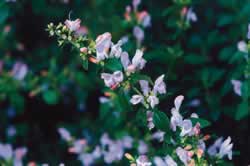 Reaching
lengths of 3 to 8 feet, the rat snake (Elaphe obsoleta) is a powerful
diurnal constrictor that preys on birds, eggs, lizards, mice, and small mammals.
Skilled climbers, rat snakes can ascend trees in search of nests and nest cavities.
Climbing rat snakes, particularly those being heckled by nesting birds, are
easy prey for hawks.
Reaching
lengths of 3 to 8 feet, the rat snake (Elaphe obsoleta) is a powerful
diurnal constrictor that preys on birds, eggs, lizards, mice, and small mammals.
Skilled climbers, rat snakes can ascend trees in search of nests and nest cavities.
Climbing rat snakes, particularly those being heckled by nesting birds, are
easy prey for hawks.
Subspecies occurring in Georgia include the black rat snake (E. o. obsoleta), which is black with occasional traces of white between its scales; the corn snake (E. guttata guttata), yellow, orange, or red with reddish-brown or reddish-orange splotches; and the gray rat snake (E. o. spiloides), characterized by dark gray to brown splotches on a whitish to gray background. Young in every subspecies have vivid blotches.
This rodent's genus name, Peromyscus, derives from the Greek words pera (pouch) and myskos (little mouse) in reference to the cheek pouches where it stores the berries, seeds, and nuts accumulated during night forages. An omnivore, the cotton mouse (Peromyscus gossypinus) will also eat slugs, spiders, and insects. It nests under old stumps, logs, and brush piles, and in dense grass clumps. Naturalist John LeConte, who named the species in 1853, discovered wisps of cotton in some rodents' nests.
The cotton mouse is the largest species in its genus, reaching total lengths of 7 to 8 inches. Its deep-brown coloring makes it the darkest mouse in the southeastern United States (despite a white belly and feet).
Mating, which occurs throughout the year, is less prevalent in midsummer and midwinter. Nests of one to seven young are born after a 23-day gestation period and they reach mature size within two months. Adults live an average of four to five months; few survive for a year.
The cotton mouse is both an adept climber and swimmer. Natural predators include owls, snakes, and foxes.
Along with the Bachman's sparrow and red-cockaded woodpecker, the brown-headed nuthatch (Sitta pusilla) forms a triumvirate of birds most closely associated with the longleaf pine-wiregrass plains of southwestern Georgia. The woodpecker's preference for older growth pine is well documented, as is the sparrow's preference for the grassland's thick groundcover. The nuthatch nests in low snags in the pine trees and subsists on the insects and larvae it pries from the trees' bark.
True to its name, the brown-headed nuthatch has a dark brown cap atop a buff- colored neck and breast and a gray back. Its call is a short double note that sounds like the squeak of a child's rubber toy. Feeding flocks may also twitter and chirp.
Its large, conspicuous mounds make the Eastern harvester ant (Pogonomyrmex badius) a visible resident of xeric longleaf pine ecosystems. This mounding activity aerates the soil (perhaps not as significant in well-drained, sandy areas) and brings nutrients to the surface. The Eastern harvester ant is the only member of its species found east of the Mississippi, occurring also in the southwestern United States.
Harvester ants are red or dark brown and fairly large at 0.16 to 0.31 inch in length. They are seed feeders. Specialized worker ants known as "soldiers" spend their days cracking seeds with their enlarged jaws to feed other ants. Longleaf pine seeds are not part of the harvester ants' diet, and they will move any seeds that fall on or near their mounds away from the area. They are also known to keep the ground around the nest clear of vegetation. Harvester ants have a blunt stinger that can produce a rather painful sting.
Some species of arthropods (a phylum of invertebrate animals with jointed limbs, segmented bodies, and chitinous shells that includes crustacea, insects, and spiders) reside exclusively in the burrows of either gopher tortoises or pocket gophers. Certain arthropods have adapted to their subterranean surroundings with reduced eye size, elongated appendages, and depigmentation. Three scarab beetles common in this ecosystem-Aphodius aegrotus, haldemani, and laevigatus-occur only in pocket gopher burrows. Copris gopheri and Onthophagus polyphemi, also scarab beetles, are obligate associates of the gopher tortoise.
The dung of their vertebrate hosts constitutes the basis for these insects' food webs. Scarabs are stout beetles ranging in length from 0.25 to 2.4 inches. Their distinctive antennae, which are composed of leaflike plates called lamellae, can be curled up or fanned out to sense odors. The beetles' front tibiae (fourth leg segment) are large to facilitate digging. Both adults and their C-shaped larvae are nocturnal.
Other species of scarab beetles, such as the five southeastern species of the genus Mycotrupes, are endemic to xeric longleaf pine uplands but dig their own burrows, leaving conspicuous mounds of sand at the entrance to tunnels that may be up to 8 feet deep. Larvae in the burrows feed on balls of dung rolled in by their parents.
Read and add comments about this page
Go back to previous page. Go to Fire Forest contents page. Go to Sherpa Guides home.
[ Previous Topic | Next Topic ]